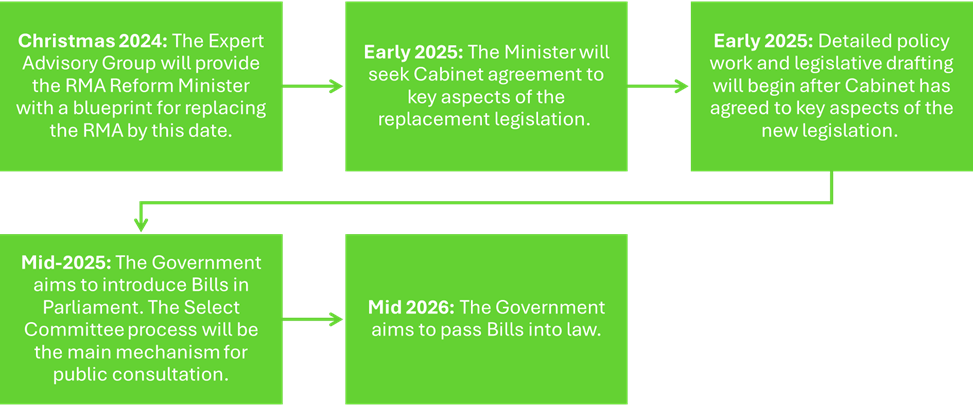These follow from the Government’s Phase 1 repeal of both the Natural and Built Environment Act 2023 and Spatial Planning Act 2023 completed in December 2023.
Phase 2
RMA Amendment Bill 2
The Government proposes to make focused changes to address key Government priorities with its soon-to-be introduced RMA Amendment Bill 2. These key priorities are:
- doubling available renewable energy;
- enabling the delivery of high-quality infrastructure;
- unlocking development capacity for housing; and
- enabling primary sector growth and development.
Scope
 |
 |
 |
 |
|
Reduce delays and improve efficiency in consenting |
Improve certainty and simplify designation process |
Extending certain coastal permit durations for port companies |
Enable housing growth |
 |
 |
 |
 |
|
Amend interface between RMA and Fisheries Act |
Better outcomes for heritage buildings |
Improving system effectiveness |
Improving natural hazard and emergency provisions |
Key proposals – highlights
|
National planning documents/ regulations / ministerial intervention National planning documents including National Policy Statements (NPSs) and National Environment Standards (NESs) are proposed to be amended including the following changes: |
|
 |
|
|
Planning and consenting Amendments proposed to planning and consenting processes include: |
|
 |
|
|
Interface with the RMA The Government has proposed amendments to the RMA in relation to the interface between the RMA and other regimes, specifically in relation to fisheries and heritage: |
|
 |
|
|
System improvements and designations MfE has also indicated that amendments will be made to the RMA to improve existing systems. Amendments will also be made to the provisions relating to designations under the RMA. Examples include: |
|
 |
|
Process for RM Bill 2

National Planning Documents
Based on the update from MfE, we are likely to see six to seven new national planning documents (NPSs or NESs) developed and 14 existing instruments amended, with targeted amendments to national planning documents through four packages:
 |
 |
 |
 |
|
Infrastructure and energy |
Housing |
Farming and primary sector |
Emergencies and natural hazards |
Below is a summary of the scope of the changes to national planning documents that the Government intends to make, as indicated by MfE. As MfE is currently in the policy development phase of this reform, we do not yet have clarity as to the exact nature of the amendments proposed.
Infrastructure and Energy
 |
Amendments to the NES-Telecommunications Facilities. |
|
New national direction to enable energy and infrastructure projects, including a new NPS-Infrastructure and subsequent standards for different types of energy generation and infrastructure. |
|
|
Amendments to the NPSs for Renewable Electricity Generation and Electricity Transmission so that they are more directive and enabling of renewable electricity and transmission. |
|
 |
Amendments to the New Zealand Coastal Policy Statement. |
Housing
 |
|
|
New national planning documents for:
|
Farming and Primary Sector
 |
This will see a wide sweep of changes to NPSs and NESs relating to freshwater, indigenous biodiversity, commercial forestry, drinking water, and marine aquaculture, as well as stock exclusion regulations. |
Emergencies and Natural Hazards
 |
New national planning documents for natural hazards management. |
Process for national planning documents
MfE has indicated that the national direction work programme will follow the process outlined in the figure below.
MfE officials explained that they are aware of the practicalities of achieving consistency between national planning documents and are hopeful that input through consultation will assist with achieving integrated national direction.

Phase 3
|
Cabinet has released 10 principles that will guide the development of proposals for Phase 3 of the reform which focusses on a top-down approach to the resource management system. The principles are covered in our earlier article here. |
|
|
Cabinet considers its guiding principle for resource management reform to be the enjoyment of property rights which is consistent with its principle to narrow the scope of the resource management system and the effects it controls. Based on the recently released Cabinet Paper ‘Replacing the Resource Management Act 1991’, we are likely to see the establishment of two Acts, one to manage environmental effects arising from activities and another to enable urban development and infrastructure. |
Process for Phase 3

Conclusion
MfE officials have made it clear that the Ministry is still very much in the developmental stage of much of Phases 2 and 3 of the Government’s proposed resource management reform. With a focus on individual property rights, the narrowing of the scope of the resource management system and the effects it controls, and increased direction from national policy statements, the Government seeks to centralise much of New Zealand’s environmental decision-making.
If you have any questions about the matters raised in this article, please get in touch with the contacts listed or your usual Bell Gully adviser.


